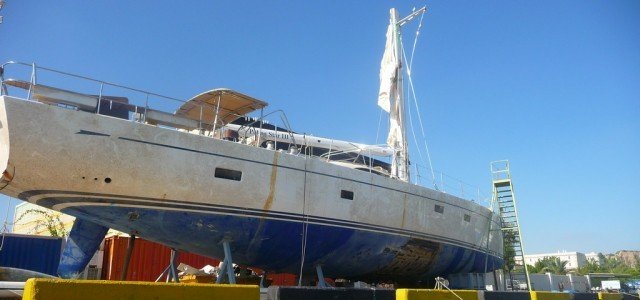
This summer, the once lovely Oyster 825 was hauled from the water with its keel missing and a large chunk of skin laminate peeled back. Another casualty in a disturbing trend. I wrote a lengthy post on the subject of keels last year, and technical editor Ralph Naranjo discussed the topic in his report Rethinking Hull Structure in the February 2015 issue of Practical Sailor.
Why so much attention to keels? The numbers speak for themselves. When the International Sailing Federation (ISAF) formed a working group to look into the keel loss issue in 2013 they tallied up 72 incidents (since 1984) that resulted in 24 deaths. Far from complete, this profile only records incidents where survivor reports or vetted second hand accounts were available, or vessel remains pinpointed to the cause of a loss. No numbers exist for cases in which sailboats simply disappeared at sea-but keel failure, resulting in major hull damage and loss of stability, certainly can’t be ruled out.
Its often hard to come by detailed information portraying what actually went wrong due to litigation and the all too regular use of gag orders that hold back the details and protect certain parties involved in the litigation. The much larger automotive and aviation industries attract more scrutiny and regulatory control and product failures gather greater attention. But when it comes to keel failures, mums the word and the bottom line question is simply-whos keeping track?
In the U.S. theres a long list of players with skin in the game-so to speak. Theres the National Marine Manufacturers Association, American Bureau of Shipping, American Boat and Yacht Council, the American Boatbuilders and Repairers Association, the Society of Naval Architects and Marine Engineers, several marine surveyor organizations and the US Coast Guard, just to name a few. And to the credit of many of these august institutions there has been serious discussion of this very topic.
But, in contrast to the Europeans effort to define keel attachment scantlings via new standards (ISO 12215-9) , theres no apparent rush in the U.S. to better define structural standards for keel attachment.
The American Bureau of Shipping (ABS) published the 1994 Guidelines for Offshore Racing Yachts that incorporated some valuable specs defining scan’tlings and engineering approaches for attaching the ballast to the hull. For example, where keel bolts penetrate the keel stub or canoe body of the hull, the laminate should be a minimum thickness equal to the diameter of the keel bolt.
Keep in mind that this spec was issued when fin and bulb keels were not as radical as they are today. Its interesting to note that many of the recent keel failures reveal hull and keel stub laminate thickness that fail to meet the 1994 ABS guidelines. Look for Naranjos more detailed report on keels in an upcoming issue of Practical Sailor. Naranjo also discusses the topic of sailboat design and structure in his excellent new book on seamanship, The Art of Seamanship is available in our online bookstore.





































